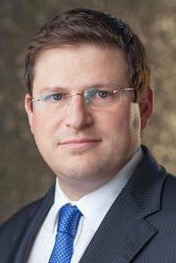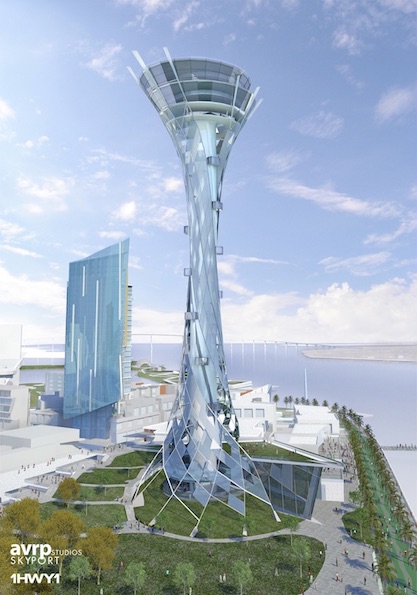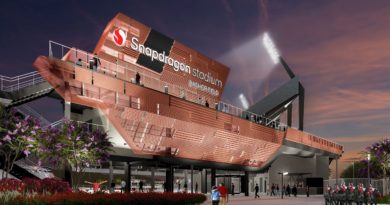Daily Business Report-Dec. 27, 2017
The San Diego Seaport project plan includes a 500-foot observation tower called ‘The Spire.’ (Photo courtesy of AVRP Studios, 1HWY1)
San Diego Seaport Project
to Transform Waterfront
By Christine Kilpatrick | Editor, ENR California
Conceptual design work continues on the Port of San Diego’s planned $1.5-billion waterfront development, as the project team ensures resiliency to future sea-level rise and inspects a newly discovered earthquake fault.
The “Seaport San Diego” project will revamp an underused area cluttered with parking lots, old tourist attractions and a fish-processing facility into a mixed-use development that includes a school, aquarium and 500-ft observation tower. Thirty of the site’s 70 acres are bay water. The site, which includes the current 14-acre Seaport Village, sits on port land with a 66-year lease.
Plans include a two-level parking garage built 20 to 30 ft underground, says Yehudi Gaffen, who leads the development team. “Because we’re so close to the water, it’s all under the water table. We’re essentially creating a big bathtub under the ground.” The parking garage’s design will include a resiliency plan for sea level rise, affecting everything from the entrance’s location to placement of electrical systems.
Operating as 1HWY1, the development team includes the newly formed Protea Waterfront Development, consisting of Gaffen’s Gafcon construction management firm, with marina adviser RCI Group and attraction concepts by ThrillCorp and OdySea. The team plans to break ground on the project in 2021 with a three- to four-year buildout.
The team is also conducting site due diligence and geotechnical analysis, ending in spring 2018, Gaffen says. An earthquake fault was recently discovered, running from the bay into the city’s downtown.
“We’re still working through the implications,” he says. “It depends on the age of the fault.” A fault that has moved within the last 11,000 years is considered “active”—it can’t be built over and buildings must be set back a certain distance. The team plans to carbon-date the fault over the next month or two, a challenge for a waterfront site where simple trenching is not an option.
The challenge facing designers and builders of “The Spire”—the development’s 500-ft tower—isn’t structural or geotechnical, but technological, Gaffen says. The Spire will feature “gondolas” circling the core of the tower, using virtual reality to take visitors 1,000 years back in time to when indigenous tribes occupied the area. A flexible technology platform is required to accommodate future advances.
“The virtual reality field is evolving so rapidly,” Gaffen says. “Eight years from now, when this project is ready to go, we have to be ready.”
This article and photo originally appeared in ENR Engineering News-Record (enr.com). Reprinted with permission. For the original article, click here.
_____________________
Study Identifies California
Cliffs at Risk of Collapse
Danger — Unstable Cliffs — Stay Back
The yellow warning signs that pepper coastal cliffs from northern California to the US-Mexico border may seem overly dramatic to the casual observer. But actively eroding cliffs make up the majority of the California coastline, and sudden landslides and collapses have caused injuries and several fatalities in recent years. In addition, eroding cliffs currently threaten highways, houses, businesses, military bases, parks, power plants, and other critical facilities—all in all billions of dollars of development.
Research suggests that erosion rates will increase as sea level rises, further exacerbating these problems. “It is critical we study current and historical cliff retreat so we can better plan for the future,” says Adam Young, a researcher at Scripps Institution of Oceanography at the University of California San Diego who recently published a unique large-scale analysis of coastal cliff erosion in California.
The study, published in the journal Geomorphology, and funded by California Sea Grant, provides accurate erosion rates for 680 miles of the California coast, from the US-Mexico border to Bodega Head in Sonoma County. It identifies areas that have eroded faster than others, and introduces a new experimental hazard scale to identify areas that may be at greater risk of impending collapse. It is the first such large-scale study in California using LiDAR data—laser elevation data recorded in aerial surveys—which were used to create detailed 3D elevation maps.
_____________________
Cristiano Amon Named President of Qualcomm Inc.

Cristiano R. Amon, executive vice president of Qualcomm Technologies Inc. and president of QCT, has been promoted to president of Qualcomm Inc., effective Jan. 4, 2018. In his new role, Amon will formulate and drive key strategies for growing the company in both Qualcomm’s core businesses, as well as new business opportunities. Amon will also continue to lead the QCT business, reporting to Steve Mollenkopf, CEO of Qualcomm Inc.
Amon joined Qualcomm in 1995 as an engineer and has subsequently held numerous business and technical leadership roles. For the past five years, Amon has been responsible for Qualcomm’s semiconductor business, first as co-president of QCT and a member of Qualcomm’s executive committee and then as president of QCT for the past two years. Prior to Qualcomm, Amon served as the chief technical officer of Vésper, a wireless operator in Brazil and held positions at NEC, Ericsson and Velocom Inc. Amon holds a Bachelor of Science degree in electrical engineering from UNICAMP – Universidade Estadual de Campinas, São Paulo, Brazil.
_____________________
Labor Unions Eye Cannabis Industry
Unions have set their sights on a rare opportunity to organize a whole new set of workers: those working with recreational marijuana in California. Labor leaders estimate recreational cannabis businesses in California could employ at least 100,000 workers.
_____________________
SDSU Offers New Language Course
Starting in the spring 2018 semester, students at San Diego State University will have the opportunity to trek into ancient Mesoamerica, through the university’s new course on the indigenous language Nahuatl.
Still used today, Nahuatl is the language of more than one million indigenous Mexicans. It was also spoken by the Aztecs and other ancient empires prior to the Spanish conquest.
SDSU is one of only four universities in the country to offer the class, joining the University of California, Los Angeles, Stanford University and the University of Utah. John Sullivan, Ph.D, a Nahuatl philologist, developed the program while at Yale University.
_____________________
San Diego Foundation Awards $230,462
in Grants to 7 Climate Change Programs
The San Diego Foundation has awarded $230,462 in grants to seven programs that will catalyze greater regional action to prepare for the impacts of climate change.
The seven nonprofit programs receiving grants include:
Center for Sustainable Energy (Equinox Project)
Water Resiliency Dashboard and Convening — $40,000
With 2016 funding, Equinox successfully transitioned the entire Quality of Life dashboard online and built out water-specific components of this unique, online tool for 500+ decision-makers and local stakeholders to better understand the state of San Diego water use and water quality. This phase two grant will help Equinox expand water-specific research.
San Diego Coastkeeper
Advancing Sustainable Water Solutions in San Diego County — $40,000This phase two grant will help Coastkeeper continue implementation of a three-year strategic plan to reduce water pollution by strengthening water quality regulations and practices; advocating for the prioritization of environmentally sensitive and energy-efficient water supply and use; and educating and activating residents to achieve clean water and sustainable water supply.
San Diego Regional Climate Collaborative
Advancing Climate-Smart Water Strategies — $40,000
This grant will help the Collaborative provide tools, trainings, leverage funding for cities to develop and implement climate action plans and local projects that promote water conservation and expand local water supplies through water and stormwater reuse in communities and city infrastructure.
Surfrider Foundation — San Diego Chapter
Carbon Connection — $40,000
This phase two grant will support Surfrider member engagement, policy outreach, public awareness and education work to create greater resilience to increased coastal flooding along the coast in San Diego County and reduce greenhouse gas emissions through sustainable water management.
Endangered Habitat League
Advancing Climate Resilience, Water Conservation, and Fire Hazard Reduction through Land Use — $30,000
This phase two grant will support work to limit the negative impact of sprawl development by advancing integration of climate change risks into implementation of the San Diego County adopted General Plan and development of a Climate Action Plan.
Water Reliability Coalition (Fiscal Sponsor: San Diego Regional Chamber Foundation)
Residential Water Rate Reform Education & Outreach — $20,462
This grant project will educate and engage the Water Reliability Coalition’s diverse members from environmental, consumer, business, labor and technical organizations about water rate reform options that can help ensure a safe, reliable, sustainable and cost-effective local water supply.
San Diego Green Building Council
Net Zero Water Education — $20,000
This phase two grant will help San Diego Green Building Council provide strategies for local leaders and encourage more developers to build “net-zero water buildings” in the region.


